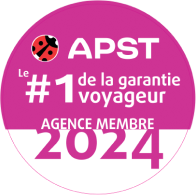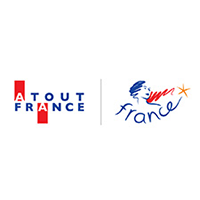Madagascar
Set off with us on a discovery of Madagascar! Be assured that your journey will be unique and original, through extraordinary landscapes where the people are always welcoming.
The first stage of this trip offers a beautiful glimpse of the richness of the Atsinanana humid forests (Eastern Madagascar), along the trails of Andasibe National Park. The remaining primary forests in Madagascar are fascinating: the levels of endemism in both flora (orchids, rosewood, medicinal plants, etc.) and fauna (l...
Day 1Departure heading east, Andasibe
Day 1Departure heading east, Andasibe
Departure for Andasibe, due east, along National Road 2 which connects the capital to Tamatave, Madagascar’s main port. Several stops are possible en route to stroll, visit villages, or discover the lush and exuberant local flora and fauna in this region of the Great Island.
Arrival early afternoon in Andasibe and check-in at the hotel. Walks in the village are possible, near the National Park which we will visit the next morning. Night visits to nearby private or community reserves are also possible (not included).
Day 2Discovery of Andasibe National Park, meeting the Indri-Indri
Day 2Discovery of Andasibe National Park, meeting the Indri-Indri
Visit of the Andasibe National Park, a conservation site for the Indri-Indri, the largest of the lemurs. We enter the primary forest of Andasibe through the former Périnet Reserve, now called Mantadia National Park, which offers visits lasting 2 to 6 hours, or more depending on our pace. We will have a choice of 5 different circuits to select on site with the local guide.
The Mantadia Reserve, accessible outside the rainy season from April to November (sometimes difficult to access in July/August), is distinguished by its large water reserve including the crossing of the 3 rivers: Iofa, Sahanody, and Vohitra. Further on, we will discover a sacred waterfall and learn about the cultural values of the area. Other animal species may be seen, including 11 other lemur species such as bamboo lemurs, sifakas, chameleons, and birds. The flora is also rich with several varieties of orchids such as eulophiella, rosewood, palms, and medicinal plants.
Day 3On the road south along National Road 7, towards the Manandona Valley and Mount Ibity
Day 3On the road south along National Road 7, towards the Manandona Valley and Mount Ibity
We leave Andasibe heading towards the Central Highlands, taking a winding road lined with small waterfalls, terraced rice fields—an inheritance from Indonesian culture—and villages with houses made of brick or red rammed earth. Passing through Ambatolampy, known for its aluminum craftsmanship.
We continue our journey toward Manandona where we stay with local families for a unique experience. In one or several traditional houses, we receive a warm welcome with basic comfort (outdoor toilets and bucket showers).
Day 4Walk along the trails of the Manandona Valley, at the foot of Mount Ibity
Day 4Walk along the trails of the Manandona Valley, at the foot of Mount Ibity
Starting from the lodge, we set out on foot to discover the typical environment of the Highlands. Nestled at the foot of the mighty Ibity massif, the Manandona Valley is rich and prosperous. The land here is also very generous, with rice as the main crop.
After gaining altitude by following good trails winding through the foothills, we return to the valley to meet the locals. All are rice farmers and own zebus; some raise silkworms, others are blacksmiths, basket weavers, or carpenters. Traditional craftsmanship is everywhere.
Our guides are members of a local association for the development of the region. They will share insights about their work, customs and traditions, and local development.
Second night with local families.
Breakfast: Village lodge | Manandona
Lunch: Picnic during the hike
Dinner: Village lodge | Manandona
Accommodation: Village lodge | Manandona
Day 5Passage through Ambositra and its woodcraft, then drive to the thermal town of Ranomafana
Day 5Passage through Ambositra and its woodcraft, then drive to the thermal town of Ranomafana
After breakfast, leaving the Manandona Valley to continue our way South. pour continuer vers le sud. We rejoin the RN7 and visit the city of Ambositra to discover the wooden crafts, close to the art of the Zafimaniry tribe. Meeting with the local craftsmen who realize incredible work out of wood.
We continue our journey to Ranomafana and its national park, home to a multitude of lemur species, which we will visit the following day. We arrive in the village at the end of the day.
Ranomafana, a fully forested park covering 41,601 ha, was listed as a World Natural Heritage Site of Atsinanana in 2007. It harbors a great wealth of endemic biodiversity that is under threat. It is home to rare and critically endangered lemur species.
The park is also the genetic reservoir for certain rare and endemic plant species. It is crossed by numerous waterways, tributaries of the Namorona River.
Day 6Exploration of Ranomafana National Park, onward to Fianarantsoa
Day 6Exploration of Ranomafana National Park, onward to Fianarantsoa
Morning discovery of the forest of Ranomafana, with its rich and varied fauna and flora. The Ranomafana National Park covers nearly 41,600 hectares of humid tropical forest. Listed as a UNESCO World Heritage Site, this forest shelters an exceptional endemic biodiversity, including many rare species unfortunately facing extinction.
You may be lucky enough to spot some of the 26 species of lemurs recorded in this area, as well as birds, butterflies, bats, chameleons, other reptiles, and amphibians. There is also a great diversity of medicinal plants, orchids, and carnivorous plants.
Keep your eyes open!
We continue our journey toward Fianarantsoa, the historical and cultural capital of the Betsileo region. It is also the Malagasy city with the largest number of cultural buildings and schools.
Like Tana, the city is divided into three parts:- The Upper Town, once home to the Merina governor’s palace, where today you can admire Protestant temples, a Lutheran college, the brick cathedral in Tuscan style, the Jesuit school of Ambozotany, and Antsenakely Square, where a small market is held.
- The New Town, the administrative district, where the zoma (Friday market) also takes place,
- The Lower Town, Ampasambazaha, the heart of the city, where the Chinese and Indian commercial districts are located.
Fianarantsoa is also known for its tea plantations and vineyards.
Day 7Pirogue descent on the Haute Matsiatra River and visit to the Sahambavy tea plantation
Day 7Pirogue descent on the Haute Matsiatra River and visit to the Sahambavy tea plantation
Departure for the village of Mahasoabe, located about twenty kilometers east of Fianarantsoa. Meeting with the pirogue paddlers, then beginning the descent of the river in a traditional pirogue.
Two and a half hours of navigation, as the river winds between rice fields and granite mountains, with numerous stops to immerse ourselves in rural life. Several species of aquatic birds can be observed. We land at the village of Iseta, and after a half-hour walk through fields and villages, we take our vehicle again to Sahambavy.
In the afternoon, visit to the only tea plantation in Madagascar, and tasting of this characterful tea. The factory was built in 1978 by the Malagasy State, then later privatized by a limited company. An average of 20 tons of fresh leaves are harvested per day from the 355 hectares of plantations, of which 94 hectares are managed by local farmers.
Return to Fianarantsoa at the end of the day.
Duration: +/- 2h30 of navigation and +/- 1h30 of walking Duration: +/- 1h transfer by car Distance: 40 km
Day 8The Ring-tailed Lemurs of the Anja Community Reserve, onward to Ranohira
Day 8The Ring-tailed Lemurs of the Anja Community Reserve, onward to Ranohira
Through the patchwork of terraced rice fields and various crops displaying every shade of green, we drive to Ambalavao, known for its vineyards.
Stop at the small Anja Community Reserve: a gallery forest of ficus, lianas, and orchids has developed among spectacular rocky outcrops, sometimes forming caves used as shelters by certain animals. On the slopes, the vegetation has been replaced by succulent plants such as kalanchoes and pachypodiums.
In this green paradise live small colonies of ring-tailed lemurs, almost the emblem of the Great Island, the makis catta. They spend much of their time on the ground, are not very shy, and are therefore easily observed. The revenues from the Anja site are managed by the AMI (Anja Miray) association and reinvested in economic and social projects aimed at improving agricultural yields, developing crafts, and supporting health and education for the surrounding villagers.
Duration: 1h walk in the Anja ReserveContinuation south into Bara country and crossing the largest plateau in Madagascar, the desert-like Horombe, before catching sight of the village of Ranohira, which we reach in the late afternoon.
Day 9Hike through the iconic Isalo National Park
Day 9Hike through the iconic Isalo National Park
A beautiful day of exploration on foot in the ruiniform massif of Isalo.
Isalo National Park was created in 1962 and is classified among exceptional parks. Stretching nearly 100 km from north to south, it is unique in Madagascar for its geomorphological formation dating from the Jurassic period: this ruiniform massif of continental sandstone, carved with deep canyons, is home to endemic rock-dwelling vegetation (aloes, euphorbias, pachypodiums…).
It also harbors exceptional wildlife, most of which is endemic, such as rock reptiles, makis, and other lemurs.
The predominant ethnic group in this region is the Bara people, who live mainly from zebu herding and agriculture. Considered descendants of the Bantu, the Bara are cattle herders as well as fierce warriors, proud and ready to do anything to defend their freedom.
Day 10Discovering the Vezo fishing village on the Mozambique Channel
Day 10Discovering the Vezo fishing village on the Mozambique Channel
We pass through the villages of Ilakaka and Sakaraha, still on the vast Horombe plateau—once quiet settlements, transformed into true mining towns worthy of the American Wild West after the discovery of a massive sapphire deposit. First glimpse of the baobabs and crossing of the Mahafaly limestone plateau, with its famous and impressive tombs topped with funerary sculptures called “Aloalo” and painted with naïve scenes of life.
Visit of Tuléar and lunch. In the early afternoon, drive to Ifaty, about thirty kilometers north of Tuléar, to reach the land of the Vezo fishermen.
Check-in at the hotel in Ifaty. Here we say goodbye to our driver-guide, who will return to the capital the following day.
Day 11-12Free stay in Ifaty
Day 11-12Free stay in Ifaty
Ifaty, Mangily, Madiorano, and Ambolimailaka are small villages facing the majestic lagoon of Ranobe, with its turquoise waters, famous for its coral reef. They serve here as seaside resorts.
Free stay, with activities available through the hotel or with your guide: hiking in the dry forest of the hinterland, home to various species of endemic spiny plants, euphorbias, Didiereaceae, pachypodiums, and baobabs.
The visit can be done by zebu cart or on foot; or simply relax and enjoy the beach, a delightful invitation to swim in this magnificent lagoon.
Other options include: speedboat excursion, outrigger pirogue ride, trolling fishing, water skiing, snorkeling, or scuba diving… Or simply take a walk along the beach, meet the local people, and discover in depth the life of these fishing villages.
Activities and transfers at your own expense, to give you more flexibility according to your wishes at the time. Excursions can be organized on request—please inquire.
Day 13Domestic flight to Antananarivo
Day 13Domestic flight to Antananarivo
Depending on the domestic flight schedule, free time before the transfer to Tuléar airport, arranged by your hotel on site.
After a wonderful seaside stay, return to Antananarivo. Domestic flight from Tuléar to Antananarivo (not included).
Meet up with your team who will welcome you upon arrival at Ivato Antananarivo Airport. Transfer to your residence address in Antananarivo.
End of our services

